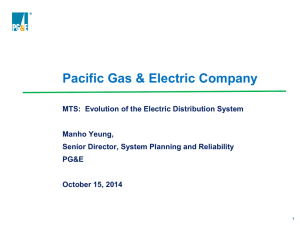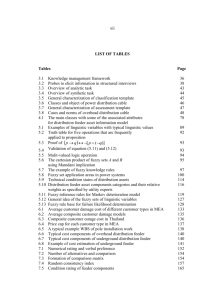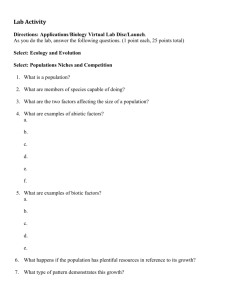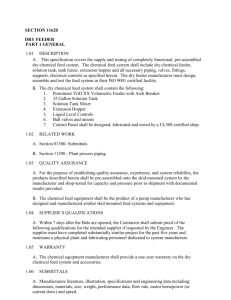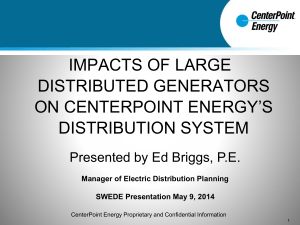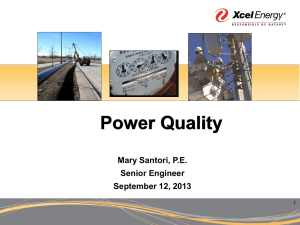AER expenditure workshop no. 10 repex & augex strawman proposal
advertisement
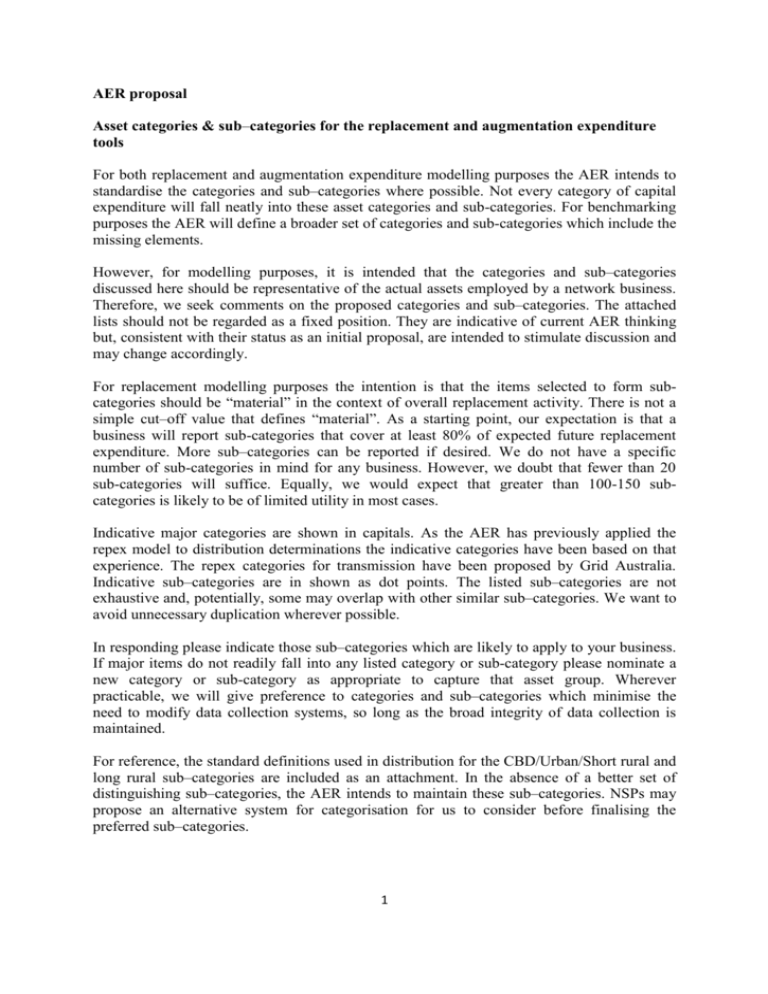
AER proposal Asset categories & sub–categories for the replacement and augmentation expenditure tools For both replacement and augmentation expenditure modelling purposes the AER intends to standardise the categories and sub–categories where possible. Not every category of capital expenditure will fall neatly into these asset categories and sub-categories. For benchmarking purposes the AER will define a broader set of categories and sub-categories which include the missing elements. However, for modelling purposes, it is intended that the categories and sub–categories discussed here should be representative of the actual assets employed by a network business. Therefore, we seek comments on the proposed categories and sub–categories. The attached lists should not be regarded as a fixed position. They are indicative of current AER thinking but, consistent with their status as an initial proposal, are intended to stimulate discussion and may change accordingly. For replacement modelling purposes the intention is that the items selected to form subcategories should be “material” in the context of overall replacement activity. There is not a simple cut–off value that defines “material”. As a starting point, our expectation is that a business will report sub-categories that cover at least 80% of expected future replacement expenditure. More sub–categories can be reported if desired. We do not have a specific number of sub-categories in mind for any business. However, we doubt that fewer than 20 sub-categories will suffice. Equally, we would expect that greater than 100-150 subcategories is likely to be of limited utility in most cases. Indicative major categories are shown in capitals. As the AER has previously applied the repex model to distribution determinations the indicative categories have been based on that experience. The repex categories for transmission have been proposed by Grid Australia. Indicative sub–categories are in shown as dot points. The listed sub–categories are not exhaustive and, potentially, some may overlap with other similar sub–categories. We want to avoid unnecessary duplication wherever possible. In responding please indicate those sub–categories which are likely to apply to your business. If major items do not readily fall into any listed category or sub-category please nominate a new category or sub-category as appropriate to capture that asset group. Wherever practicable, we will give preference to categories and sub–categories which minimise the need to modify data collection systems, so long as the broad integrity of data collection is maintained. For reference, the standard definitions used in distribution for the CBD/Urban/Short rural and long rural sub–categories are included as an attachment. In the absence of a better set of distinguishing sub–categories, the AER intends to maintain these sub–categories. NSPs may propose an alternative system for categorisation for us to consider before finalising the preferred sub–categories. 1 REPEX: Asset categories & sub–categories for distribution replacements POLES steel towers on a distribution line steel towers on a sub– transmission line monopoles on a distribution line monopoles on a sub–transmission line wooden HV poles* on a CBD feeder wooden HV poles* on an urban feeder wooden HV poles* on a short rural feeder wooden HV poles* on a long rural feeder concrete HV poles on a CBD feeder concrete HV poles on an urban feeder concrete HV poles on a short rural feeder concrete HV poles on a long rural feeder wooden LV poles* on a CBD feeder wooden LV poles* on an urban feeder wooden LV poles* on a short rural feeder wooden LV poles* on a long rural feeder concrete LV poles on a CBD feeder concrete LV poles on an urban feeder concrete LV poles on a short rural feeder concrete LV poles on a long rural feeder * Add additional sub-categories for staked and un-staked poles if relevant POLE TOP STRUCTURES pole top structures on a CBD feeder pole top structures on an urban feeder pole top structures on a short rural feeder pole top structures on a long rural feeder pole top structures on a SWER HV feeder Break down each of these sub-categories by voltage level OVERHEAD CONDUCTORS bare sub– transmission conductors (excluding services assets) bare conductors (excluding services assets) on a 3–phase HV CBD feeder bare conductors (excluding services assets) on a 3–phase HV urban feeder bare conductors (excluding services assets) on a 3–phase HV short rural feeder bare conductors (excluding services assets) on a 3–phase HV long rural feeder bare conductors (excluding services assets) on a single–phase HV CBD feeder (if any) bare conductors (excluding services assets) on a single–phase HV urban feeder (if any) bare conductors (excluding services assets) on a single–phase HV short rural feeder bare conductors (excluding services assets) on a single–phase HV long rural feeder bare conductors (excluding services assets) on a SWER HV feeder bare conductors (excluding services assets) on a LV CBD feeder 2 bare conductors (excluding services assets) on a LV urban feeder bare conductors (excluding services assets) on a LV short rural feeder bare conductors (excluding services assets) on a LV long rural feeder covered or ABC conductors (excluding services assets) on a HV CBD feeder covered or ABC conductors (excluding services assets) on a HV urban feeder covered or ABC conductors (excluding services assets) on a HV short rural feeder covered or ABC conductors (excluding services assets) on a HV long rural feeder covered or ABC conductors (excluding services assets) on a LV CBD feeder covered or ABC conductors (excluding services assets) on a LV urban feeder covered or ABC conductors (excluding services assets) on a LV short rural feeder covered or ABC conductors (excluding services assets) on a LV long rural feeder UNDERGROUND CABLES underground submarine cables (excluding services assets) on a sub–transmission line underground non–submarine cables (excluding services assets) on a sub–transmission line underground submarine cables (excluding services assets) on a HV CBD feeder underground non–submarine cables (excluding services assets) on HV CBD feeder underground submarine cables (excluding services assets) on a HV urban feeder underground non–submarine cables (excluding services assets) on HV urban feeder underground submarine cables (excluding services assets) on a HV short rural feeder underground non–submarine cables (excluding services assets) on HV short rural feeder underground submarine cables (excluding services assets) on a HV long rural feeder underground non–submarine cables (excluding services assets) on HV long rural feeder underground cables (excluding services assets) on LV CBD feeder underground cables (excluding services assets) on LV urban feeder underground cables (excluding services assets) on LV short rural feeder underground cables (excluding services assets) on LV long rural feeder SERVICES overhead services assets underground services assets DISTRIBUTION TRANSFORMERS pole–mounted distribution transformers <50 kVA pole–mounted distribution transformers ≥50 kVA and ≤300 kVA pole–mounted distribution transformers >300 kVA ground–mounted distribution transformers <50 kVA ground–mounted distribution transformers ≥50 kVA and ≤300 kVA ground–mounted distribution transformers >300 kVA Note: “Ground–mounted” wherever mentioned includes kiosk and pad mounted equipment 3 DISTRIBUTION SWITCHGEAR pole–mounted ACR pole–mounted HV circuit breaker pole–mounted air/gas switch pole–mounted EDO fuse pole–mounted other fuse pole–mounted surge diverter pole–mounted HV links ground–mounted ACR ground–mounted HV circuit breaker ground–mounted air/gas switch ground–mounted EDO fuse ground–mounted other fuse ground–mounted surge diverter ground–mounted HV links Note: AER query - Do DNSPs routinely distinguish between ground mounted and pole mounted for these items? DISTRIBUTION OTHER ASSETS other distribution substation assets ZONE TRANSFORMERS zone transformers with <10 MVA ONAN rating zone transformers with ≥10 MVA and ≤50 MVA ONAN rating zone transformers with ≥50 MVA and ≤100 MVA ONAN rating zone transformers with >100 MVA ONAN rating ZONE SWITCHGEAR CBs ST switches HV switches CTs VTs/CVTs isolators, disconnectors, and/or earth switches Break down each of these sub-categories by voltage level ZONE OTHER ASSETS other sub– transmission substation, switching station, and zone substation assets SCADA & PROTECTION protection relays breakdown by technology type (eg. electro-mechanical, analogue, and digital) other SCADA and protection assets 4 CUSTOMER METER ASSETS customer meter assets: single–phase LV meter customer meter assets: 3–phase LV meter customer meter assets: LV CT / meter customer meter assets: HV CT / meter PUBLIC LIGHTING ASSETS public lighting luminaires on major roads public lighting brackets on major roads public lighting lamps on major roads public lighting poles / columns (sole use) on major roads public lighting other assets on major roads public lighting luminaires on minor roads public lighting brackets on minor roads public lighting lamps on minor roads public lighting poles / columns (sole use) on minor roads public lighting other assets on minor roads OTHER ASSETS other network assets major plant and equipment (vehicle fleet/elevated work platforms/trucks/etc) IT Mainframe systems Cloud based systems PC/Desktop/CAD systems An IT category was proposed by Grid Australia. We have not previously considered whether IT is suitable for repex modelling. If deemed appropriate, an IT category may be extended to distribution. 5 REPEX: Asset categories for transmission replacement modelling TRANSMISSION (OVERHEAD) LINES steel towers by voltage level (eg. 220/275/330/500 kV) monopoles/pylons by voltage level conductors (km) by voltage level and by conductor type TRANSMISSION CABLES Conductors (km) by voltage (eg. 220/275/330/500 kV) Sub–categories by insulation type SUBSTATION SWITCHBAYS Circuit breakers: sub–categories by voltage level and by type (eg. air break/oil insulated/gas insulated) Isolators/disconnectors Surge diverters SUBSTATION POWER TRANSFORMERS Separate by nominal voltage level and by capacity Whether air cooled/fan cooled SUBSTATION REACTIVE PLANT (SVCs, CAPACITORS AND REACTORS) Sub– categories differentiated by voltage level SVCs Capacitors Synchronous Condensers Reactors SECONDARY SYSTEMS Sub– categories to be differentiated by voltage level Current transformers Voltage transformers Protection relays Other COMMUNICATIONS SCADA Optical fibre Other Communications OTHER ASSETS other network assets major plant and equipment (vehicle fleet/elevated work platforms/trucks/etc) 6 IT Mainframe systems Cloud based systems PC/Desktop/CAD systems An IT category was proposed by Grid Australia. We have not previously considered whether IT is suitable for repex modelling. If deemed appropriate, an IT category may be extended to distribution. 7 AUGEX: Augmentation network segments / sub–categories for transmission modelling (Differentiate by voltage level) Transmission lines – serving CBD/Urban Transmission lines – serving rural areas Transmission lines – serving generators Substations – serving CBD/Urban Substations – serving rural areas Substations – serving generators Note: Sub-category to be determined by the primary/dominant use of the asset AUGEX: Augmentation network segments / sub–categories for distribution modelling sub–transmission lines (group by voltage level) sub–transmission substations (incl. sub–transmission switching) (group by primary voltage level when transforming between voltage levels) zone substations (group by voltage level) high voltage feeders – CBD high voltage feeders – urban high voltage feeders – short rural high voltage feeders – long rural distribution substation – CBD distribution substation – urban distribution substation – short rural distribution substation – long rural LV feeder – CBD LV feeder – urban LV feeder – short rural LV feeder – long rural The AER will consider whether, due to the high numbers of LV feeders in particular, an approach based on a representative sampling should be adopted for LV feeders. 8 ATTACHMENT Regional & density definitions “CBD feeder” means a high voltage feeder or a low voltage feeder supplying primarily commercial high– rise buildings via an underground cable network. “Urban feeder” means a high voltage feeder or a lower voltage feeder that is not a CBD feeder and for which the annual average maximum demand per total feeder route length over the last 5 full financial years immediately preceding the date of submitting a regulatory reporting statement is greater than 300 kVA per kilometre. “Rural feeder” means a high voltage feeder or a lower voltage feeder that is not a CBD feeder and for which the annual average maximum demand per total feeder route length over the last 5 full financial years immediately preceding the date of submitting a regulatory reporting statement is less than or equal to 300 kVA per kilometre. “Short rural feeder” means a rural feeder that has a route length less than or equal 200 kilometres. “Long rural feeder” means a rural feeder that has a route length greater than 200 kilometres. 9
